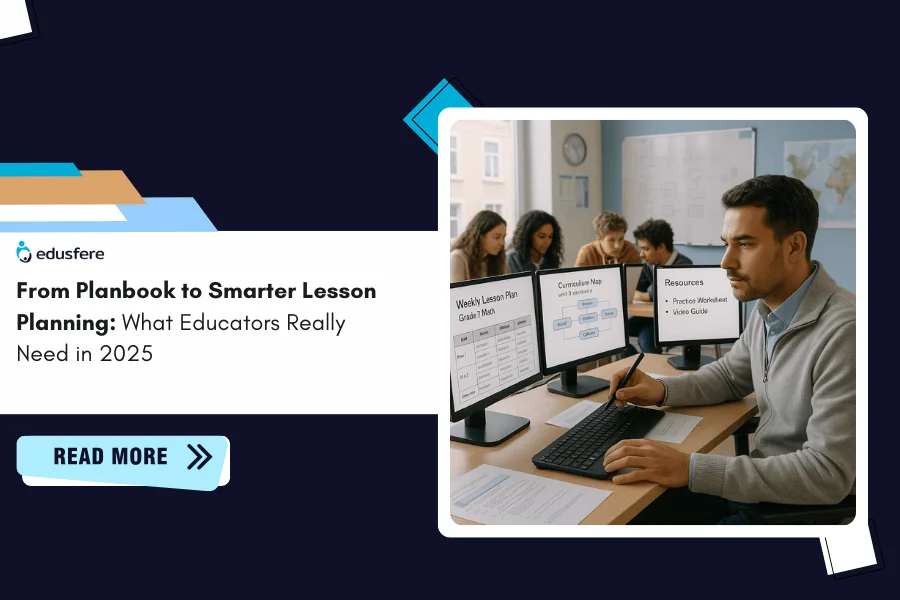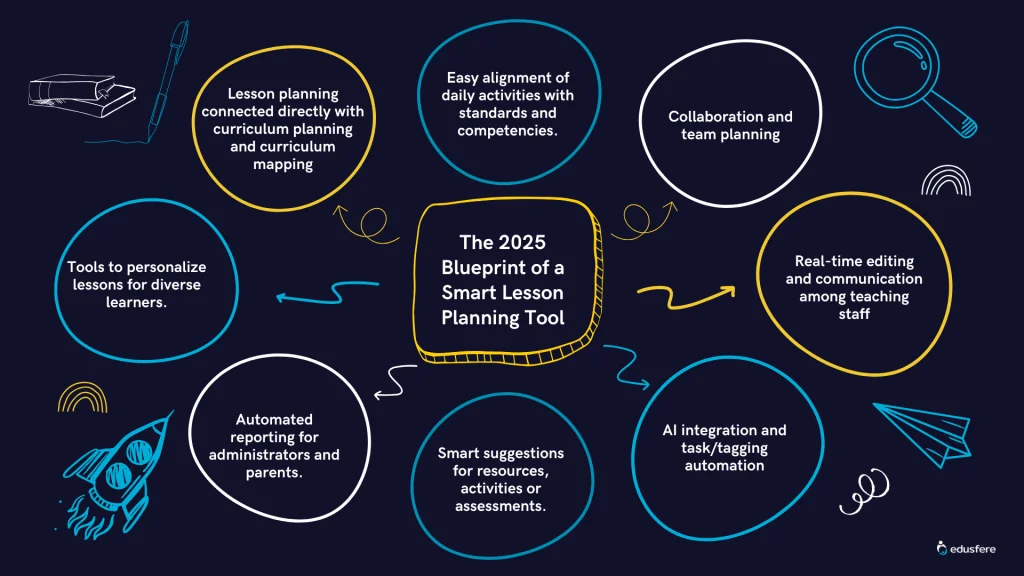Schedule a free demo to learn more
From Planbook to Smarter Lesson Planning: What Educators Really Need in 2025
25th Sept 2025

Lesson planning has always been the backbone of effective teaching. For decades, teachers have relied on notebooks, spreadsheets and eventually digital planners like Planbook to stay organized. These tools made the transition from paper to digital possible, helping educators keep track of lessons, schedules and classroom activities.
But in 2025, classrooms are evolving faster than ever. Teachers are expected to integrate technology, align lessons with broader curriculum goals, personalize instruction and provide measurable outcomes. All of this while managing time more efficiently. This raises a natural question many educators ask today,i.e., is basic digital lesson planning enough or do we need smarter, more integrated solutions?
The answer lies in the shift toward lesson planning platforms that combine curriculum mapping, curriculum planning and collaboration into one seamless experience.
What is Lesson Planning and Why Does it Matter More Than Ever in 2025?
Lesson planning is no longer just about writing down what you’ll teach on a given day. In modern classrooms, lesson planning is the process of:
- Aligning daily instruction with long-term curriculum goals.
- Incorporating multiple teaching strategies for diverse learners.
- Using technology to provide interactive, engaging learning experiences.
- Building flexibility so lessons can adapt to real-time classroom needs.
Educators in 2025 face unique challenges including hybrid learning, digital-native students and data-driven performance requirements. This means lesson planning has grown from a routine task to a strategic activity that impacts student success on a much larger scale.
How is Lesson Planning different from Curriculum Planning and Curriculum Mapping?
One of the most common questions educators raise on AI platforms is about the difference between these terms. Let’s break it down:
Lesson Planning: The process of lesson planning primarily focuses on daily or weekly instructional activities including what to teach, how to teach it and what resources to use.
Curriculum Planning: Curriculum planning often involves structuring the overall scope and sequence of instruction across a term or year. Ensures coverage of standards and learning goals.
Curriculum Mapping: Curriculum mapping majorly focuses on the alignment of units and lessons with broader outcomes, standards and competencies. It provides a big-picture view of how lessons contribute to long-term student growth.
In 2025, educators need solutions that bridge all three seamlessly. Without this integration, teachers risk spending hours juggling separate systems or missing opportunities to connect daily lessons with broader learning goals.
What features should Smarter Lesson Planning tools offer in 2025?

When teachers ask about what makes lesson planning smarter today, the answers usually revolve around features that go beyond scheduling. Smarter lesson planning tools in 2025 should include:
- Seamless curriculum integration
- Lesson planning connected directly with curriculum planning and curriculum mapping
- Easy alignment of daily activities with standards and competencies.
- Collaboration and team planning
- Shared lesson libraries for departments or grade-level teams.
- Real-time editing and communication among teaching staff
- Data-driven insights
- AI integration and task/tagging automation
- Smart suggestions for resources, activities or assessments.
- Automated reporting for administrators and parents.
- Tools to personalize lessons for diverse learners.
These are the features that teachers increasingly expect in 2025 that often help them move from managing lessons to maximizing impact.
So if you’re looking at simple collaborative lesson plan templates, go for Planbook. However, if you’re looking for seamless lesson planning along with all of the above features, Edusfere is your go-to tool.
Why basic Lesson Planning tools aren’t enough anymore
Teachers continue to share this frustration about having a digital planner, but it still feels like they’re doing most of the heavy lifting. This reflects the gap between traditional tools and modern expectations. While tools like Planbook handle the structure, they don’t always:
- Connect lessons to larger curriculum outcomes.
- Provide analytics or insights on what’s working.
- Reduce time spent on repetitive planning tasks.
In other words, teachers still need to manage curriculum planning, mapping and collaboration separately, which often eats into time they’d rather spend teaching.
So what do educators really need in 2025?
Educators today are looking for platforms that:
- Combine lesson planning, curriculum planning and curriculum mapping into one hub.
- Offer real-time collaboration among teaching teams.
- Provide data-driven insights that guide better instructional decisions.
- Use automation and AI to save time and personalize lessons.
The shift is evident. Educators don’t just want a digital planner, they need an intelligent teaching partner.
The Future of Smarter Lesson Planning: Where does Edusfere fit in?
While traditional tools have helped teachers take the first step into digital planning, modern platforms are redefining what’s possible. This is where Edusfere stands out. Edusfere combines lesson planning, curriculum mapping and curriculum planning in a single, integrated platform. Unlike tools limited to basic scheduling, Edusfere is designed for the realities of 2025 encompassing:
- Collaborative lesson planning across teams and departments.
- AI-powered insights and automation that reduce repetitive tasks.
- Seamless alignment between daily teaching and long-term curriculum goals.
- Adaptability for hybrid classrooms and personalized instruction.
For educators, this means less time spent juggling systems and more time focusing on what matters most,i.e. student learning.
The Evolution From Planbook to Smarter Planning
Planbook and similar tools will always hold value as early digital planners but the needs of 2025 demand more. Teachers no longer want to just plan; they want to teach smarter, collaborate seamlessly and see measurable results.
That’s why the evolution from traditional lesson planning to smarter platforms like Edusfere is more than just a tech upgrade. It’s a transformation in how educators approach teaching itself, ensuring lessons are not only organized but also impactful, connected and future-ready.
Are you willing to leverage the benefits of a modern, AI-powered curriculum mapping software?
Schedule a demo session with Edusfere today!